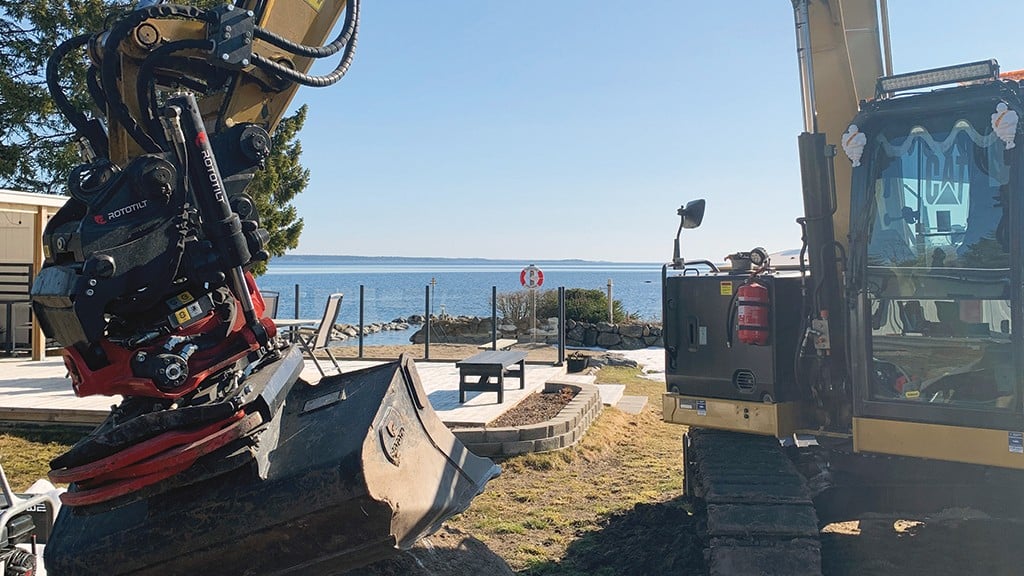How tiltrotator-equipped excavators make efficient work of landscaping tasks

Grading, material handling and compaction are all tasks for an excavator on a landscaping job, and if you're looking for an edge, outfitting your machine with a tiltrotator can deliver some impressive benefits. Here's how adding a tiltrotator to your excavator can change how you approach landscaping jobs.
How does using a tiltrotator benefit landscaping applications?
"One of the biggest benefits to using a tiltrotator is probably the fact that you can fit a machine into a very confined space, which is oftentimes the case with landscaping," says Jeremy Lindsay, sales and marketing manager with Rototilt Inc.
The tiltrotator allows you to work at many different angles, to tilt or rotate your attachments, and to work in front of the carrier, beside the carrier or behind the carrier, but still control the direction of the attachment. He adds that this is of big benefit to reduce machine repositioning, which is safer and gets the job done faster.
While efficiency gains are hard to pin down precisely as they will be job-specific, Lindsay says that Rototilt has seen some contractors, who have allocated five days to do a landscaping job, complete the work in a day and a half or two days. That's a significant time savings, but he adds that there are other advantages that aren't as immediately apparent – less moving of the machine reduces wear on the undercarriage, for example.
Tiltrotator + 3D software = a dynamic duo
When it comes to grading, a machine with a tiltrotator can get the job done faster than a machine without one, says Lindsay, and when you add 3D software onto the machine, you can accomplish even more with pre-programmed contours and can avoid guesswork.
While the majority of machines don't have this technology yet, Lindsay says that as more machines from OEMs are outfitted with 3D technology, more operations become interested in carrying through the investment to adding a tiltrotator as well, typically with larger machines.
What are the carrier requirements for tiltrotators?
As long as your machine meets the correct hydraulic flow requirements for the tiltrotator (which can be compared on manufacturers' websites), then pretty much every excavator produced today can utilize a tiltrotator, says Lindsay.
From there, it's a question of the control system that you will use on your tiltrotator, and there are two variations:
A full-featured electric set-up requires one hydraulic circuit on the machine. All of the valves to switch hydraulic functions for tilt, rotate, bucket shake and other features will go through that circuit.
If the machine has two hydraulic circuits on it, which is a more expensive feature on excavators, the tiltrotator will function the same, but requires less electronic control as one hydraulic circuit will control the tilt function and the other will control rotation.
What attachments are compatible with tiltrotators?
Common attachments for use with tiltrotators include buckets, grapples, compactors and rippers. A tiltrotator can be used with attachments from the tiltrotator manufacturer, or third party attachments.
Depending on the manufacturer of your third-party attachments, you may have to fabricate or purchase a bracket to bolt on the top of the attachment, says Lindsay. That bracket will need to be the same as the tiltrotator's bottom coupler, which is the open S Standard. Most tiltrotator manufacturers use the Open S coupler so that they all have the same lugging on the lower end of the tiltrotator and the top end of their attachments and buckets.
Rototilt sells modification kits for attachments that don't have the Open S coupler, complete with lugs and pins.
Once an operator is set up with their attachments, swapping attachments is easy. On the bottom of the tiltrotator is the hydraulic quick coupler which enables the operator to change the attachment from the cab. If they're using a hydraulic attachment with a standard tiltrotator they'll have to get out and connect the hydraulic lines. If the tiltrotator is equipped with Rototilt's QuickChange (other manufacturers have their variations on this feature), full hydraulic connection can be completed from the cab.
How does adding a tiltrotator to your machine change the job site?
Adding a tiltrotator to your excavator means that you can use fewer machines on the job site and have fewer labourers working around the excavator.
With a compactor, a bucket and a grading beam on that one machine, you can get a lot of landscaping tasks done, says Lindsay.
And, if you're digging a swimming pool, for example, you don't have to have someone in the hole measuring for depth when you're using 3D modelling software, which reduces safety risks on the job site.
How does outfitting an excavator with a tiltrotator open up more business opportunities?
Adding a tiltrotator to your machine opens up a contractor to bid on more jobs, says Lindsay, and having a full suite of attachments in your arsenal can help. For example, adding a compactor can allow you to grade at a fine level, and you'll be able to bid on a job that has that requirement.
Another business opportunity that a tiltrotator can open up is simply the ability to take on more jobs because of the time savings – instead of taking five days to do a job, if you can do it in two, that can open up a lot of opportunities.
Company info
441 Henry St, Unit 1
Brantford, ON
CA, N3S 7V6
Website:
rototilt.com
Phone number:
519-754-2195



